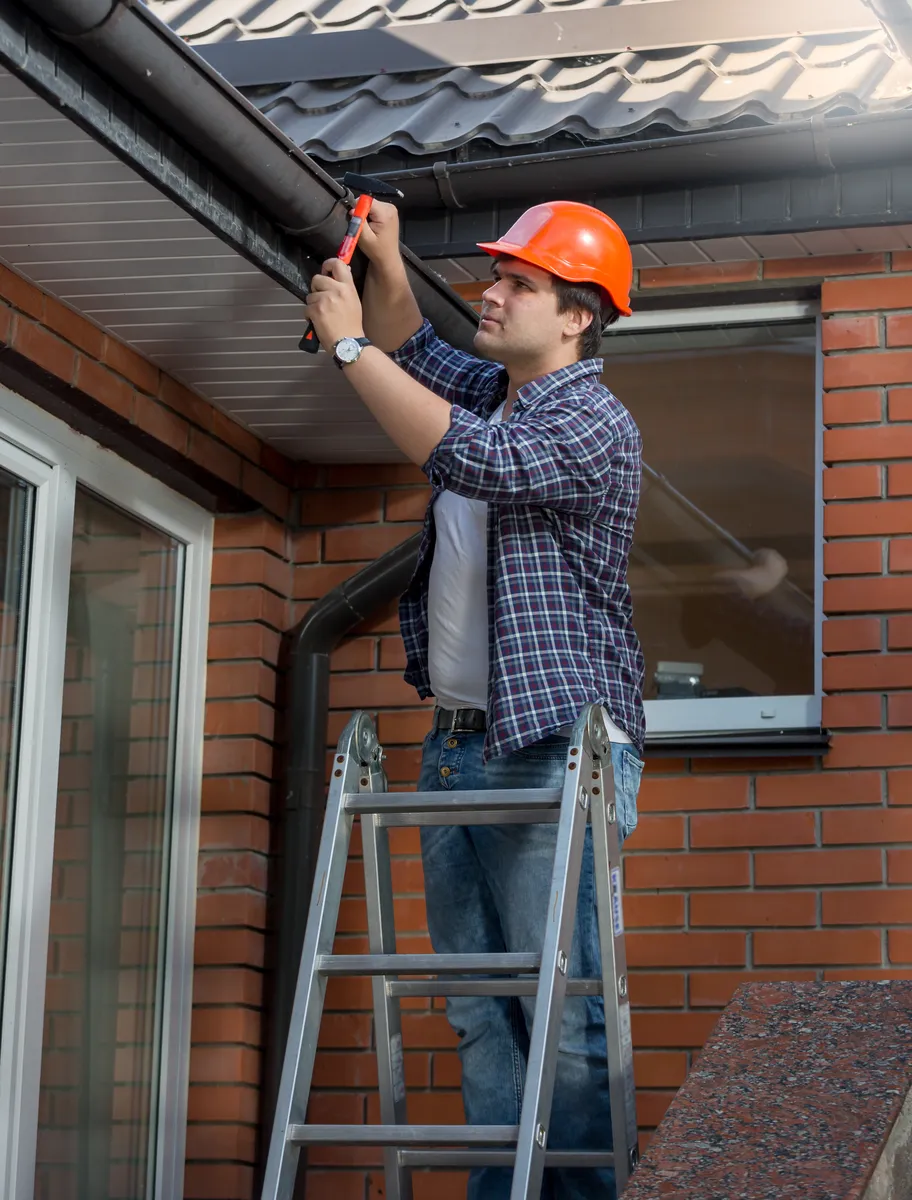Calculating the right gutter size for your home is a crucial step in preventing overflow and damage.
Start by measuring each section of your roof and multiplying the dimensions to get the square footage.
Add up all the sections to determine the total area.
Don’t forget to factor in the roof pitch for efficient drainage – use a level and tape measure to find this angle.
Consider the maximum rainfall intensity in your area to select the appropriate gutter size.
Consult a sizing chart for guidance, especially if you live in a region prone to heavy rainfall.
By making these calculations, you can ensure your gutters are equipped to handle any weather conditions.
Keep reading to discover the perfect gutter size for your home!
We’ll provide you with a gutter quotation for your property in no time!
Key Takeaways
- Start by measuring the length and width of each section of your roof to figure out the total square footage.
- Take into account the slope of your roof by adjusting the total area using the pitch factor.
- Check the maximum rainfall intensity in your area to determine the right size for your gutters.
- Refer to a gutter sizing chart that matches your calculated square footage and adjusted pitch to find the suitable gutter size.
- If you live in an area with heavy rainfall, consider opting for larger gutters like 6-inch ones for better water management.
Why Is Gutter Size Calculation Important?
Proper gutter calculations play a crucial role in safeguarding your home from water damage.
Getting the right gutter size ensures that rainwater is efficiently diverted away.
Away from your foundation, walls, and roof, reducing the risk of costly repairs.
If your gutters are too small, they can easily get overwhelmed during heavy rainfall.
This leads to overflow and potential water infiltration into your basement.
On the flip side, oversized gutters may seem like a good idea.
But they can strain your home’s exterior and inflate installation costs without providing any extra benefits.
It’s all about finding the perfect balance to ensure your gutters function effectively.
Well-sized gutters not only protect your home’s structure but also enhance its appearance and functionality.
They help maintain proper drainage around your property. This prevents soil erosion and keeps your plants healthy.
Additionally, correctly sized gutters can help prevent ice dams in colder climates.
This can wreak havoc on your roof and gutters if not addressed.
How To Calculate Gutter Size?
When figuring out how to calculate the gutter size, start by measuring each section of your roof for length and width.
Multiply these dimensions to find the square footage and add them all up to get the total roof area.
Next, take into account the pitch of your roof, as it affects how water drains off.
To measure the pitch, use a 2-foot level and a tape measure.
Hold the level against the roof and measure the distance from the roof to the underside of the level at its midpoint.
For instance, if you have a 5-inch gap at the 12-inch mark, your pitch is 5-in-12.
Apply a pitch factor to the roof square footage: no multiplier for 0-3 inches, 1.05 for 4-5 inches, 1.1 for 6-8 inches, and 1.2 for 9-11 inches.
You can also use an online gutter size calculator to help you calculate gutter sizing precisely.
Gutter size calculations are crucial for effective water drainage.
Factors like roof slope, rainfall intensity, and the size of the drainage area influence the selection of the right gutter system for optimal performance.
What Are The Required Tools To Measure Gutters?
When measuring gutters, you’ll need some basic tools like a tape measure, ladder, notepad, safety gear, and a level to ensure you get the right measurements.
These tools are essential for avoiding issues like water overflow and erosion around your home.
A tape measure is necessary for determining the diameter, length, and width of your gutters.
A stable ladder is vital for reaching your gutters safely; ensure it’s on solid ground to prevent accidents.
Safety gear like gloves and goggles protects you from sharp edges and debris, making the process safer and more efficient.
A notepad comes in handy for jotting down measurements and notes to avoid missing any important details.
Lastly, a level helps you check the slope of the gutters to ensure proper water flow towards the downspouts.
Here’s a quick list of tools you’ll need:
- Tape measure
- Ladder
- Safety gear (gloves, goggles)
- Notepad
What Are The Factors That Influence Gutter Size?
The first one is the size of your roof. Larger roofs collect more rainwater, so they need bigger gutters to handle the extra volume.
To figure out your roof’s size, just multiply the length and width of each section and add them all up.
Another factor to consider is the pitch of your roof.
Steeper roofs make water run off faster, which means you’ll need larger gutters.
You can measure the pitch by using a 2-foot level and a tape measure.
Hold the level against the roof, make sure it’s level, and measure the vertical distance from the roof to the midpoint of the level.
This pitch affects how quickly water runs off and determines the gutter size you need.
Lastly, the maximum rainfall intensity in your area plays a role in deciding the size of your gutters.
You can find this information from local weather services.
Multiply your roof’s size by a pitch factor (based on your roof’s pitch) and the maximum rainfall intensity.
This adjusted size helps you figure out the right gutter size for your home.
In general, 5-inch gutters are usually enough, but areas with heavy rainfall might need 6-inch gutters.
How To Calculate Gutter Capacity?
To determine your gutter capacity, start by noting down the width, depth, and length of your gutters.
These measurements are crucial for calculating how much water your gutters can handle.
Here’s a simple guide to help you out:
- Measure the Width and Depth: Grab a tape measure and determine the interior width and depth of your gutter. These measurements will help you figure out the cross-sectional area.
- Measure the Length: Measure the length of each section of your gutter. Multiply the cross-sectional area by the length to get the total capacity.
- Consider the Rainfall Intensity: Find out the average rainfall intensity in your area. This will ensure that your gutters can manage heavy rain without overflowing.
- Take into Account Roof Size: The size and slope of your roof impact how much water flows into your gutters. Larger roofs will require gutters with a higher capacity.
How To Find Downspout Dimensions?
Use a tape measure to get the diameter of the downspout from one edge to the other for precise sizing.
Standard downspout lengths usually fall between 8 to 10 feet.
Measuring the height from your gutter to the ground will help you determine the exact length needed.
Don’t forget to think about extensions if you need to direct water farther away from your foundation.
These extensions are crucial to prevent water from accumulating around your home.
Calculating the number of downspouts required is essential. It depends on your roof area and the intensity of rainfall in your region.
A good rule of thumb is to have one downspout for every 20 to 30 feet of gutter length.
Ensuring that the downspouts match your gutter capacity is key to avoiding any overflow issues.
How To Determine The Roof Pitch?
Determining the roof pitch is a straightforward process that you can do with just a 2-foot level and a tape measure.
Simply place one end of the level against the roof, ensuring it’s perfectly horizontal.
Then, measure the vertical distance from the roof surface to the underside of the level at its midpoint.
For example, if you find a 5-inch gap at the 12-inch mark, you have a 5-in-12 pitch.
Understanding your roof’s pitch is crucial because a steeper roof means water will run off faster, impacting the size of gutters you’ll need.
Here’s a simple guide to adjust your calculations based on the pitch:
- 0-3 inches: No additional calculation needed.
- 4-5 inches: Multiply the roof area by 1.05.
- 6-8 inches: Multiply by 1.1.
- 9-11 inches: Multiply by 1.2.
These adjustments account for the increased runoff on steeper pitches.
By accurately determining the roof pitch, you can ensure your gutter system is adequately sized to manage water runoff.
Once you know the roof pitch, you can move on to calculating the right gutter size for your home.
How Does Roof Pitch Affect The Gutter Size?
Roof pitch directly affects the required gutter size by influencing the rate of water runoff.
The steepness of the roof is referred to as the roof pitch factor. It plays a crucial role in determining the necessary gutter size.
Steeper roofs with higher pitch factors lead to faster water flow.
Calculating the roof pitch factor is essential for selecting the appropriate gutter size.
When dealing with steep roofs, considering the roof pitch factor is vital.
This is for accurately determining the gutter size required to manage water runoff effectively.
By taking into account the roof pitch factor, you can ensure that your gutters are adequately sized to handle the specific needs of your roof.
How To Measure Rain Gutter Size?
Determining the right size for your rain gutters is key to managing water runoff effectively from your home.
To start determining your rain gutter dimensions, calculate the square footage of your roof.
This is done by multiplying the length and width of each section and then adding them all up.
Take into account the pitch of your roof by using a 2-foot level and tape measure.
This is to measure the pitch factor based on the gap from the roof to the level mid-point.
Consider the maximum rainfall intensity in your area and adjust your roof square footage accordingly.
Multiply this adjusted square footage by the intensity to get the final adjusted square footage.
Use a gutter sizing chart to match this adjusted square footage with the recommended gutter width.
Typically, 5-inch gutters are standard, but for areas with heavy rainfall, consider opting for 5 or 6 inch gutters.
Who Can Help Me Calculate The Gutter Size?
If you’re looking at how to calculate roof gutter size, consider consulting with experienced roofers.
These professionals have the expertise to assess your roof’s specific requirements accurately.
They take into account factors like the size of your roof, its slope, and the typical rainfall in your area.
By working with these details regularly, they can recommend the ideal gutter size for your home and ensure a proper installation.
You can also turn to your local home improvement store for assistance.
Many of these stores have knowledgeable staff who can help you calculate the correct gutter size based on your roof’s dimensions.
They often provide free consultations and can guide you through the selection of different gutter options.
If you prefer a DIY approach, there are online calculators available that can help you estimate the necessary gutter size.
These tools typically require you to input details about your roof, such as its size, slope, and local rainfall patterns.
While online calculators can give you a rough estimate, it’s still advisable to consult with a professional.
Alternatively, hiring a contractor specializing in gutter installation can save you time.
A professional contractor won’t only handle the calculations but also take care of the installation process.






